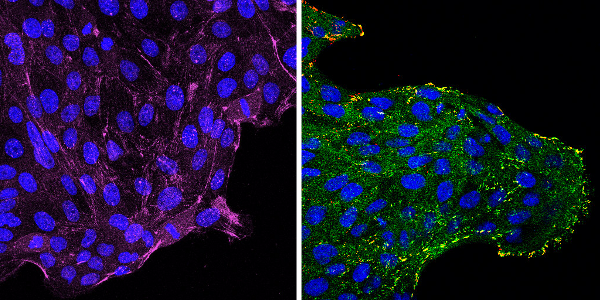Measuring the mechanical forces of disease

"All these complicated diseases that we don't have a good handle on—they all have this mechanical component. Well why is that?"
This is exactly the question Brent Hoffman, Duke biomedical engineering assistant professor, is helping answer. Many of the common diseases that we fear have a mechanical component. In asthma attacks, a chemical or physical stimulus causes the air channels in the lung to shut as the muscles that control the width of the channel contract– the mechanical component.
Another example is atherosclerosis, commonly known as the hardening of the arteries, the leading killer in developed countries. Instead of air flow, blood flow is affected as the walls of the blood vessels get thicker. Factors such as smoking, being overweight, and having high cholesterol increase the chance of getting this disease. However, examining the mechanical portion, the plaques associated with atherosclerosis tend to occur at certain parts of the blood vessels, where they branch or curve. You can think of it like a hose. When you kink a hose or put your thumb over the nozzle, the fluid flows in a different way. Hoffman said there are similar stories concerning mechanical portions of major diseases, such as muscular dystrophy and breast cancer.
This all sounds very biological, so why is he in the engineering department? As mechanobiology is a new field, there are few tools available for reporting a protein's shape or its forces inside living cells. Hoffman makes the tools enabling the study of mechanobiology. During Hoffman's postdoctoral research, he worked on recording forces across proteins in living cells, their natural environment. Now, he's expanding that technology and using it to do basic science studies to understand mechanobiology.
Hoffman said he hadn't planned this. From high school, he knew he wanted to be an engineer. As an undergraduate, Hoffman interned at IBM, where he worked on the production of chip carriers using copper-plating. Hoffman was able to apply knowledge, such as changing pH to get various amounts of copper, and make everything perform at optimal performance, but he wanted to know more about the processes.
So he set out to get his Ph.D in process control, which involves deciding how to set all the numbers and dials on the equipment, how large the tank should be, what pressure and temperature should be used, etc. in chemical plants. Hoffman was set on the path to become a chemical engineer. However, during the first week of graduate school, he attended a biophysics talk, in which he understood very little. Biophysics interested Hoffman, so he went from intending to do research on one of the most applied engineering projects on campus to arguably one of the least applied in a week. This was the beginning of his biophysics journey. However, as his Ph. D was much more heavily interested in the physics aspect, Hoffman chose to do his postdoc in cell biology to balance his training. Mixing everything together, he got biomedical engineering.
Hoffman reflects that his decisions were logical, but he had not planned to take the route he did. Hoffman cautions that it is better to have a plan than not because if you do not plan, you won't know where you are going. However, he advises that since a person learns more about likes and dislikes as one proceeds on their route, students should not be afraid to incorporate what they learn into their plans.
Hoffman's journey is characterized by finding and doing what he enjoyed. Trained in both the worlds of physics and biology, but never intending to pursue a future in either, Hoffman is uniquely suited for his current position in the revolutionary emerging field of mechanobiology. He is able to put his biology hat on and his physicist hat on for a bit, while the engineer in him is thinking, "is any of this practical?"
"If you had to pick out the key to my success, it would be doing that," Hoffman said.


















